Hobbit Human-Like Species Found on Flores Island in Indonesia

Introduction
Hobbits lived among modern humans as recently as 18,000 years ago? In a page straight out of J.R.R. Tolkien's Lord of the Rings, scientists have discovered the bones of a bipedal hominin, named Homo floresiensis, that stood about the size of a three-year-old human. Unlike human dwarfism, but similar to Hobbits, these creatures were proportionally smaller in all aspects of body size, including skull and brain size. Homo floresiensis had a brain size less than half that of a newborn and only about one third of a modern human adult.
Skull appearance
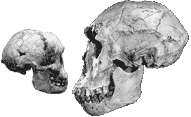 For nearly all features, the skull of Homo floresiensis matches
that of Homo erectus, other than being much smaller.1 In this regard,
it differs from modern humans in the shape of the cranium and chin (see
table below). In addition, the foramen magnum (the opening in the base of
the skull for the spinal cord) is elongated (generally considered a
primitive trait) compared to modern humans.
For nearly all features, the skull of Homo floresiensis matches
that of Homo erectus, other than being much smaller.1 In this regard,
it differs from modern humans in the shape of the cranium and chin (see
table below). In addition, the foramen magnum (the opening in the base of
the skull for the spinal cord) is elongated (generally considered a
primitive trait) compared to modern humans.
A follow-up study of the creatures brain size and dimensions, published in
March, 2005, revealed that the brain shape was similar to that of Homo
erectus, other than being much smaller.2
| Australopithecus africanus |
Homo erectus |
Homo floresiensis |
Homo sapiens |
|---|---|---|---|
 |
 |
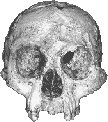 |
 |
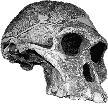 |
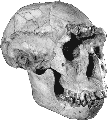 |
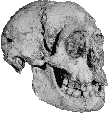 |
 |
 |
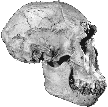 |
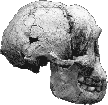 |
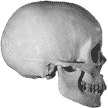 |
Bones used for walking
The bones involved in walking exhibit both advanced and primitive characteristics. The ilium (part of the pelvis) flares out much more than moderns humans, which is more vertical. The bones of the legs do not exhibit prominent areas for muscle attachment, which could be due, at least partially, to their small stature. The upper part of the femur (upper leg bone), called the lesser trochanter, is more similar to modern humans than H. erectus and A. africanus. However, the neck of the femur is long, similar to A. africanus. Several other measurements of the femur also fall within the range seen in A. africanus. In addition, the end of the femur that attaches to the knee has a similar bicondylar angle to that seen in A. africanus. The tibia (one of the lower leg bones) has characteristics that are more similar to chimpanzees than members of the Homo genus.
Bones of the foot
It turned out that H. floresiensis seem to have had "clown feet," since its feet were much longer than that found in modern humans. In fact, a comparison among the metatarsals of Homo floresiensis, Homo sapiens, and Pan troglodytes (chimpanzees), show that H. floresiensis shows foot proportions much closer to chimpanzees than those of modern humans.3 The differences are so striking that the authors of the study conclude that "the ancestor of H. floresiensis was not Homo erectus but instead some other, more primitive, hominin whose dispersal into southeast Asia is still undocumented."3
How did they live?
Bones from multiple individuals were found in the same cave. Multiple dating techniques revealed that these bones varied in date from 37,000 to 18,000 years ago.4 Another bone dated from 74,000 years ago could not be definitely assigned to the new species, although the individual was calculated to be the same height as the other individuals discovered. The morphology of all the bones remained the same, despite at least 20,000 years of intervening time. Other bones found in the cave included fish, frog, snake, tortoise, varanids, birds, rodents and bats - likely prey of these creatures, since some showed evidence of being charred. Also found in the cave were bones of at least 26 Stegodons (a dwarf elephant weighing over 2000 lbs.) Scientists suggested that H. floresiensis hunted these Stegodons. Limited, crude stone tools were found with the actual skeleton, although more sophisticated stone tools were found in other parts of the cave and in more ancient layers, usually associated with the Stegodon skeletons. Some scientists have suggested that larger Homo sapiens had hunted and killed the Stegodons, although no bones from modern humans were found in the cave. The prospect of a three-year-old-sized human hunting a one ton creature seems somewhat unlikely, even considering most of the skeletons represented juveniles (especially since these creatures probably traveled in herds containing protective adults). However, a recent report found evidence of 840,000-year-old stone artifacts from central Flores, suggesting that pre-H. sapiens hominids had been using stone tools on the island for many years.5
Could H. floresiensis be just a dwarf?
Some creationists have speculated that H. floresiensis is just a dwarf human. However, dwarfism in humans results from several factors - none of which result in the kind of morphology seen in H. floresiensis. For example, in African pygmies, a defect in insulin-like growth factor 1 (IGF-1) results in smaller stature, although brain size is unaffected. Likewise, pituitary dwarfism and primordial microcephalic dwarfism does not result in the features seen in H. floresiensis. Another study has shown that the brain of modern human microcephalics does not resemble that of the H. floresiensis specimen.2 Therefore, this creature was not just a small human, but a unique species.
Another report in PNAS asserted that the skeleton was not that different from indigenous peoples of the area.6 Reportedly, Australomelanesian population variation falls within the the anatomy found in the Homo floresiensis skeleton, although the size of the skull is still about one-third the size of normal Australomelanesians. Therefore, the authors of the study propose that the H. floresiensis type specimen represents a modern H. sapiens that suffered from congenital abnormalities. Although their point about facial non-symmetry is valid, there is a question about whether these distortions represent pre- or post mortem-changes. It seems very unlikely that a microencephalic dwarf, who demonstrates multiple skeletal deviations would represent the only ancient skeleton from Flores. Obviously, the discovery of other specimens would go a long way to resolving the controversy.
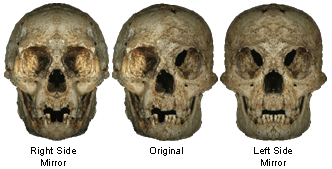
|
| Adapted from Jacob et al, 2006. Asymmetric lighting in the original image (which exaggerated apparent differences) was corrected using Adobe Photoshop. |
Countering this study was another later one that examined the wrist bones of the specimen.7 These bones clearly indicated that the wrist was similar to African apes and not modern humans, leading the authors to suggest that Homo floresiensis evolved from a branch of apes prior to the development of modern human anatomy. Ape-like wrist bones is not associated with microencephalic dwarves. Two additional partial skeletons, in addition to the type specimen, were analyzed for mandibles and teeth, and all three showed similar morphology, suggesting that the type specimen did not suffer microencephaly (unless the other two also did).8
Proof or problem for evolution?
Evolutionists were completely caught off-guard by the discovery of a new hominin species. The authors of the study suggested that these creatures had evolved from Homo erectus ancestors. However, all individuals recovered from the cave exhibited similar morphology - even though separated by up to 56,000 years of minimal change or evolution. Dwarfism resulting in the kind of changes required to produce dwarf functional brains would not be expected to occur rapidly, due to the vast number of simultaneous changes necessary. Unless scientists find intermediates between Homo erectus and Homo floresiensis, 56,000 years of stasis do not support an evolutionary explanation. Peter Brown, a paleoanthropologist at the University of New England in New South Wales, Australia admitted, "H. floresiensis presents an intriguing problem in evolutionary biology."6 Debbie Argue, et al. admitted in their recent paper that "Homo floresiensis, a primitive hominin that survived until relatively recent times is an enormous challenge to paradigms of human evolution."9 Their cladistic analysis came up with two possible phylogenetic trees, one from Homo rudolfensis and the other from Homo habilis.
However, the biblical creation model says that God created many different species of animals, including bipedal primates. How can we tell which model is correct? Biblical creation says that all species are specially created by God. Therefore, we would not expect to find any intermediates between Homo erectus and Homo floresiensis. Paleoanthropologist are actively searching the Island of Flores and surrounding islands to find similar or intermediate species. My prediction is that they will find more examples of Homo floresiensis, but no intermediates. Time will tell.
Conclusion 
The unexpected discovery of a hobbit-sized hominid in the islands of Southeast Asia present a quandary for evolutionists, since its primitive morphology and yet recent appearance does not fit with any known evolutionary ancestors. Recent reports have even speculated that the species evolved from an as yet undiscovered ancestor, since it doesn't fit the evolutionary paradigm. Did Homo floresiensis evolve or was it specially created by God. Stay tuned for the continuing saga...
Related Pages 
- Flores Man from Nature (publisher of the studies)
- Descent of Mankind Theory: Disproved by Molecular Biology

![]() Who Was Adam?: A Creation Model Approach to the Origin of Man. Are
humans just advanced apes or have they been specially created in the image of
God? Publications by scientists almost never ask the question, whereas
publications by theists seldom examine the scientific data that relates to the
question. However, two scientists raised in non-Christian homes, Fuz Rana (Ph.D.
in chemistry) and Hugh Ross (Ph.D. in astronomy), have written a new book (Who
Was Adam?: A Creation Model Approach to the Origin of Man) that examines
the question of human origins by comparing biblical and evolutionary models.
Who Was Adam?: A Creation Model Approach to the Origin of Man. Are
humans just advanced apes or have they been specially created in the image of
God? Publications by scientists almost never ask the question, whereas
publications by theists seldom examine the scientific data that relates to the
question. However, two scientists raised in non-Christian homes, Fuz Rana (Ph.D.
in chemistry) and Hugh Ross (Ph.D. in astronomy), have written a new book (Who
Was Adam?: A Creation Model Approach to the Origin of Man) that examines
the question of human origins by comparing biblical and evolutionary models.
References 
- Brown, P., T. Sutikna, M. J. Morwood, R. P. Soejono, Jatmiko, E. W. Saptomo and R. A. Due. 2004. A new small-bodied hominin from the Late Pleistocene of Flores, Indonesia. Nature 431: 1055-1061.
- Falk, D., C. Hildebolt, K. Smith, M. J. Morwood, T. Sutikna, P. Brown, Jatmiko, E. Wayhu Saptomo, B. Brunsden, F. Prior. 2005. The Brain of LB1, Homo floresiensis. Science DOI: 10.1126/science.1109727.
- Jungers, W.L., W.E. Harcourt-Smith, R.E. Wunderlich, M.W. Tocheri, S.G. Larson , T. Sutikna, R.A. Due, and M.J. Morwood. 2009. The foot of Homo floresiensis. Nature 459: 81-84.
- Morwood, M. J., et al. 2004. Archaeology and age of a new hominin from Flores in eastern Indonesia. Nature 431: 1087-1091.
- Brumm, A., A. Fachroel, G. D. van den Bergh, M. J. Morwood, M. W. Moore, I. Kurniawan, D. R. Hobbs and R. Fullagar. 2006. Early stone technology on Flores and its implications for Homo floresiensis. Nature 441, 624-628.
- Jacob, T, E. Indriati, R. P. Soejono , K. Hs�, D. W. Frayer, R. B. Eckhardt, A. J. Kuperavage, A. Thorne, and M. Henneberg. 2006. Pygmoid Australomelanesian Homo sapiens skeletal remains from Liang Bua, Flores: Population affinities and pathological abnormalities. Proc. Natl. Acad. Sci. USA, 10.1073/pnas.0605563103.
- Tocheri, M. W., C. M. Orr, S. G. Larson, T. Sutikna, Jatmiko, E. W. Saptomo, R. A. Due, T. Djubiantono, M. J. Morwood, and W. L. Jungers. 2007. The Primitive Wrist of Homo floresiensis and Its Implications for Hominin Evolution. Science 317: 1743-1745.
- Brown P and T. Maeda. 2009. Liang Bua Homo floresiensis mandibles and mandibular teeth: A contribution to the comparative morphology of a new hominin species. J. Hum. Evol. doi:10.1016/j.jhevol.2009.06.002.
- Argue, D. M. Morwood, T. Sutikna, Jatmiko and W. Saptomo. 2009. Homo floresiensis: A cladistic analysis. J. Hum. Evol. doi:10.1016/j.jhevol.2009.05.002.
http://www.godandscience.org/evolution/hobbit.html
Last Modified August 3, 2009


